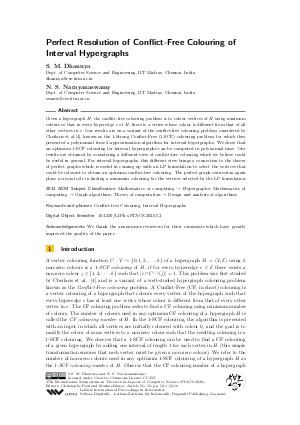@InProceedings{dhannya_et_al:LIPIcs.STACS.2020.52,
author = {Dhannya, S. M. and Narayanaswamy, N. S.},
title = {{Perfect Resolution of Conflict-Free Colouring of Interval Hypergraphs}},
booktitle = {37th International Symposium on Theoretical Aspects of Computer Science (STACS 2020)},
pages = {52:1--52:16},
series = {Leibniz International Proceedings in Informatics (LIPIcs)},
ISBN = {978-3-95977-140-5},
ISSN = {1868-8969},
year = {2020},
volume = {154},
editor = {Paul, Christophe and Bl\"{a}ser, Markus},
publisher = {Schloss Dagstuhl -- Leibniz-Zentrum f{\"u}r Informatik},
address = {Dagstuhl, Germany},
URL = {https://drops.dagstuhl.de/entities/document/10.4230/LIPIcs.STACS.2020.52},
URN = {urn:nbn:de:0030-drops-119138},
doi = {10.4230/LIPIcs.STACS.2020.52},
annote = {Keywords: Conflict-free Colouring, Interval Hypergraphs}
}

 Creative Commons Attribution 3.0 Unported license
Creative Commons Attribution 3.0 Unported license






